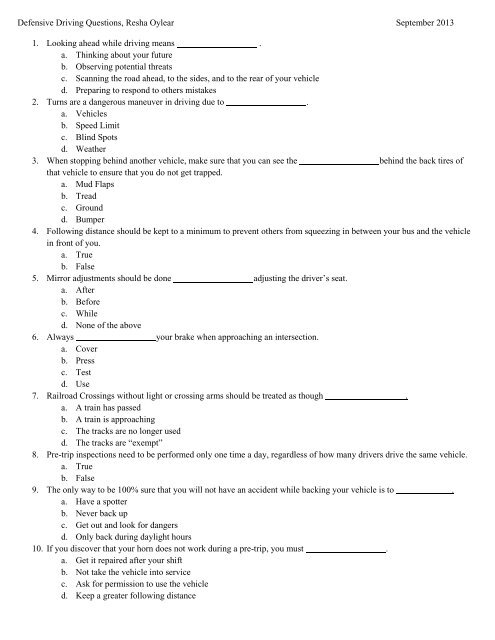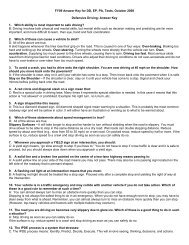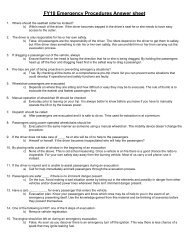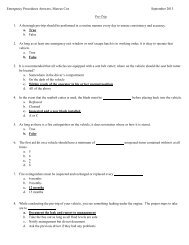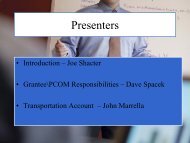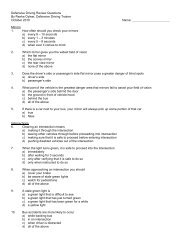RTAC Defensive Driver Test
RTAC Defensive Driver Test
RTAC Defensive Driver Test
- No tags were found...
You also want an ePaper? Increase the reach of your titles
YUMPU automatically turns print PDFs into web optimized ePapers that Google loves.
<strong>Defensive</strong> Driving Questions, Resha Oylear September 2013<br />
1. Looking ahead while driving means .<br />
a. Thinking about your future<br />
b. Observing potential threats<br />
c. Scanning the road ahead, to the sides, and to the rear of your vehicle<br />
d. Preparing to respond to others mistakes<br />
2. Turns are a dangerous maneuver in driving due to .<br />
a. Vehicles<br />
b. Speed Limit<br />
c. Blind Spots<br />
d. Weather<br />
3. When stopping behind another vehicle, make sure that you can see the behind the back tires of<br />
that vehicle to ensure that you do not get trapped.<br />
a. Mud Flaps<br />
b. Tread<br />
c. Ground<br />
d. Bumper<br />
4. Following distance should be kept to a minimum to prevent others from squeezing in between your bus and the vehicle<br />
in front of you.<br />
a. True<br />
b. False<br />
5. Mirror adjustments should be done adjusting the driver’s seat.<br />
a. After<br />
b. Before<br />
c. While<br />
d. None of the above<br />
6. Always your brake when approaching an intersection.<br />
a. Cover<br />
b. Press<br />
c. <strong>Test</strong><br />
d. Use<br />
7. Railroad Crossings without light or crossing arms should be treated as though .<br />
a. A train has passed<br />
b. A train is approaching<br />
c. The tracks are no longer used<br />
d. The tracks are “exempt”<br />
8. Pre-trip inspections need to be performed only one time a day, regardless of how many drivers drive the same vehicle.<br />
a. True<br />
b. False<br />
9. The only way to be 100% sure that you will not have an accident while backing your vehicle is to .<br />
a. Have a spotter<br />
b. Never back up<br />
c. Get out and look for dangers<br />
d. Only back during daylight hours<br />
10. If you discover that your horn does not work during a pre-trip, you must .<br />
a. Get it repaired after your shift<br />
b. Not take the vehicle into service<br />
c. Ask for permission to use the vehicle<br />
d. Keep a greater following distance
11. are obstructions of the drivers view.<br />
a. Blind Spots<br />
b. Mirrors<br />
c. Buildings<br />
d. Large Vehicles<br />
e. All of the above<br />
12. Jaywalkers do not have the right-of-way.<br />
a. True<br />
b. False<br />
13. Turn signals, brake lights, flashers, and headlights are all considered devices.<br />
a. Dangerous<br />
b. Communication<br />
c. Optional<br />
d. Control<br />
14. The white line at a stop sign is only a guide as to where to stop, not a requirement.<br />
a. True<br />
b. False<br />
15. Before pulling into an intersection, the driver must make sure that they can get all the way through the intersection<br />
without .<br />
a. Pulling forward<br />
b. Shifting gears<br />
c. Turning head<br />
d. Stopping<br />
16. A safe following distance is one to two car lengths, regardless of the speed you are traveling.<br />
a. True<br />
b. False<br />
17. Which of the following is not a factor in braking distance<br />
a. Speed vehicle is traveling<br />
b. Amount of pressure on brake pedal<br />
c. Reaction time<br />
d. Daylight<br />
18. The safest position of hands on the steering wheel is .<br />
a. 3 and 9<br />
b. 12 and 6<br />
c. 10 and 2<br />
d. 4 and 8<br />
19. To eliminate blind spots caused by fixed objects, the driver should in their seat until they can see<br />
around the obstruction.<br />
a. Lift up<br />
b. Move<br />
c. Sit<br />
d. Rest<br />
20. Looking out for “stale green lights” means to watch for .<br />
a. Faded lights<br />
b. Lights that have been green for a while<br />
c. Lights that are yellow<br />
d. Lights that just turned green
21. Which is more dangerous, driving while fatigued or driving while texting<br />
a. They are both the same<br />
b. Fatigued driving<br />
c. Texting while driving<br />
d. Neither are dangerous<br />
22. Safe drivers check their mirrors every .<br />
a. Chance they get<br />
b. 5 – 8 seconds<br />
c. So often<br />
d. Time they check their speedometer<br />
23. Daytime headlights are sufficient when it is raining.<br />
a. True<br />
b. False<br />
24. Uses of cell phones, talking to passengers, and/or looking at a map while driving, are all examples<br />
of<br />
which increase the chances of an accident.<br />
a. Motivators<br />
b. Distractions<br />
c. Good habits<br />
d. Best practices<br />
25. When stopping to load/unload a passenger, it is best practice to stop within of the curb.<br />
a. 18 inches<br />
b. 1 – 5 inches<br />
c. 6 – 12 inches<br />
d. 4 feet<br />
26. When being tailgated, for your safety, increase your .<br />
a. Speed<br />
b. Stopping distance<br />
c. Following distance<br />
d. Space to the right<br />
27. Whose job is it to watch out for the pedestrian’s safety<br />
a. The Pedestrian<br />
b. Police<br />
c. The bus driver<br />
d. Their friends<br />
28. When approaching parked cars on the side of the roadway, be prepared for .<br />
a. Opening doors<br />
b. Sudden entry into your lane<br />
c. Small children/animals walking in between cars<br />
d. All of the above<br />
29. Only prescription medicine is acceptable when operating a vehicle. Never take over the counter medicine before<br />
operating a vehicle transporting passengers!<br />
a. True<br />
b. False<br />
30. When driving a vehicle with air bags, keep as distance between you and the air bag as possible,<br />
for your safety.<br />
a. Little<br />
b. Much
31. Hydroplaning is when the tires .<br />
a. Touch the ground, not the water<br />
b. Lose contact with the ground<br />
c. Skid on the pavement<br />
d. Slip off of the car<br />
32. Professional drivers develop unsafe behaviors when they become .<br />
a. Complacent<br />
b. Happy<br />
c. Successful<br />
d. Busy<br />
33. If backing you vehicle is required, always .<br />
a. Get out and look for dangers<br />
b. Warn others with communication devices such as four way flashers<br />
c. Check your mirrors<br />
d. Listen for warning devices from other vehicles<br />
e. All of the above<br />
34. If you must travel directly next to another vehicle, make sure to .<br />
a. Let them know you are there<br />
b. Travel at the same speed<br />
c. Remain Calm<br />
d. None of the above. NEVER travel directly next to another vehicle<br />
35. Vehicles that can seat 16 or more passengers, including the driver, are NOT required to stop at railroad crossings.<br />
a. True<br />
b. False<br />
36. The side Convex mirrors provides the best view of the vehicle.<br />
a. Behind<br />
b. The lane next to<br />
c. In front of<br />
d. None of the above<br />
37. Following distance is the space directly between your vehicle and the .<br />
a. Intersection<br />
b. Curb<br />
c. Vehicle in front of you<br />
d. All of the above<br />
38. Braking for a turn is best done the turn.<br />
a. Through<br />
b. Before<br />
c. After<br />
d. All the way through<br />
39. The greatest responsibility of a driver is the of its passengers.<br />
a. On-time performance<br />
b. Safety<br />
c. Comfort<br />
d. Customer service<br />
40. You are driving defensively when you are .<br />
a. Prepared for other driver’s mistakes<br />
b. Going the speed limit<br />
c. Driving slow<br />
d. Ready for a challenge
41. It is okay to cross over a double yellow line to pass a slow moving vehicle.<br />
a. True<br />
b. False<br />
42. Green lights do not mean “GO”, they mean .<br />
a. Stop<br />
b. Proceed with caution<br />
c. Wait<br />
d. Hurry<br />
43. When traveling behind a vehicle that has left their turn signal on for a long period, you should .<br />
a. Maintain your speed<br />
b. Pass them as soon as possible<br />
c. Honk your horn<br />
d. Increase your following distance and expect the unexpected<br />
44. While driving on a country road you see someone on a bicycle in your lane traveling the same direction as you, you<br />
should .<br />
a. Stay in your lane and pass them<br />
b. Slow down and try to get their attention<br />
c. Slowly pass them by, leaving plenty of space between you and them<br />
d. Stay behind them<br />
e. Both B and C<br />
45. Illinois law now permits motorcycles and bicyclists to proceed through a red light after they have waited a reasonable<br />
time and it has not changed to green.<br />
a. True<br />
b. False<br />
46. If a deer runs out in front of your vehicle, you should .<br />
a. Drive off the road to avoid hitting them<br />
b. Stay in your lane, slowly apply your brake, and hit the deer if it does not get out of the way in time<br />
c. Honk and try to avoid the deer<br />
d. Speed up in hopes that the deer will run away<br />
47. Cell phone usage should be limited to .<br />
a. Use while vehicle is stopped<br />
b. Personal Calls<br />
c. Hands free calling<br />
d. Five minutes or less<br />
48. It is impossible to maintain a space cushion while driving in heavy traffic.<br />
a. True<br />
b. False<br />
49. Controlled intersections are intersections with .<br />
a. Police Officers<br />
b. Lights<br />
c. Stop Signs<br />
d. Yield Signs<br />
e. B, C, and D<br />
50. Motorcycles fit in tight spaces. <strong>Driver</strong>s must watch out for them especially when .<br />
a. Changing lanes<br />
b. Turning Right<br />
c. There are blind spots<br />
d. Approaching intersections<br />
e. All of the above


